Seguimiento de los programas de transferencias monetarias
Los firmantes del Gran Pacto se comprometieron a aumentar el uso de los PTM y a utilizar marcadores comunes para medir estos incrementos. Aunque el seguimiento del volumen de los PTM está comenzando a realizarse de manera más efectiva, todavía persisten los desafíos técnicos y políticos. Estos incluyen:
- Definir qué datos se desea recolectar y cómo recolectarlos;
- Garantizar el compromiso y el uso de las categorías de datos y sistemas;
- Abordar las deficiencias de los sistemas de notificación existentes que no han sido diseñados para incluir o desagregar, dinero en efectivo, cupones y otras modalidades;
- Llegar a un acuerdo común sobre las categorías estándar para la presentación de informes a fin de evitar datos incompletos e incoherentes.
Prioridades actuales
Desde 2017 a 2019, la CALP Network colideró el Subgrupo de trabajo de asistencia en efectivo del Gran Pacto sobre el seguimiento de los PTM junto a la Dirección General de Ayuda Humanitaria y Protección Civil de la Comisión Europea (DG ECHO, por sus siglas en inglés), con el principal objetivo de acordar los requisitos mínimos para el seguimiento de los PTM. Esto incluye la integración de los PTM en los sistemas y plataformas de información interinstitucional clave, a saber, el Servicio de Seguimiento Financiero (FTS, por sus siglas en inglés) y el módulo de proyectos HPC de la Oficina de Coordinación de Asuntos Humanitarios (OCHA, por sus siglas en inglés), el Estándar de Datos de la Iniciativa Internacional para la Transparencia de la Ayuda (IATI, por sus siglas en inglés), y los informes de 3W (quién hace qué, dónde). El subgrupo de trabajo sobre seguimiento de los PTM ha sido fusionado en el subgrupo de trabajo de eficiencia, eficacia y relación costo-beneficio, que la CALP Network seguirá coliderando.
Contenido destacado

Tracking Cash & Voucher Assistance Workshop – Part 2: Report
Presentation
Do you want to read the latest on discussions on how to best track cash and voucher assistance in global interagency reporting systems? The CALP Network and ECHO have just released Tracking Cash & Voucher Assistance Workshop – Part 2: Report. Key recommendations emerging from the workshop are summarized below. These will be used in the coming months as a basis to develop guidance for...

Measuring Cash Transfer Programming – Scoping study
Report
This scoping study explores technical and policy issues that are constraining progress towards better measurement and reporting of Cash Transfer Programming (CTP) and addresses these to identify ways forward. The study was developed with the following objectives: • Map and document how different implementing agencies and donors are measuring cash and voucher programming data at the...

Tracking Cash and Voucher Assistance: Agreements, recommendations and minimum requirements from the Grand Bargain cash workstream
Guidelines and Tools
This document comprises the key outputs of the work undertaken through the Tracking Cash and Voucher Assistance (CVA) Working Group from 2017 to 2019. The Tracking CVA Working Group was established as the
platform for engagement and decision-making for the sub-workstream on Tracking CVA, which is part of the Grand Bargain Cash Workstream. The Tracking CVA sub-workstream was co-led by the the...
Líder temática
Últimos recursos
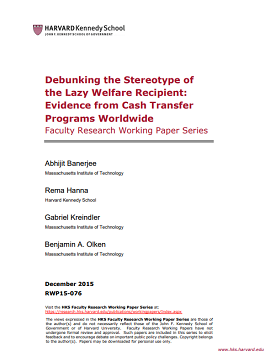
Debunking the Stereotype of the Lazy Welfare Recipient: Evidence from Cash Transfer Programs Worldwide
Report
Targeted transfer programs for poor citizens have become increasingly common in the developing world. Yet, a common concern among policy makers – both in developing as well as developed countries – is that such programs tend to discourage work. We re-analyze the data from 7 randomized controlled...

Value for Money of Cash Transfers in Emergencies
Report
The objective of this study is to analyse evidence on the Value for Money (VfM) of cash transfers. The study reviews evidence on the economy, efficiency and effectiveness of cash, vouchers and in-kind transfers, in order to support a more structured analysis of the VfM of different transfers. It is based...
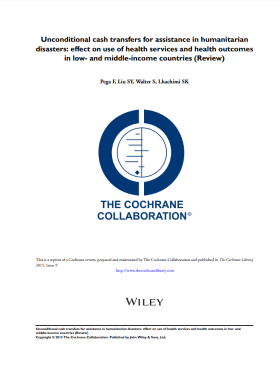
Unconditional Cash Transfers for Assistance in Humanitarian Disasters: Effect on use of health services and health outcomes in low- and middle-income countries
Report
Unconditional cash transfers (UCTs) for humanitarian assistance during disasters may improve health in low- and middle-income countries (LMICs) by giving recipients additional income. This study sought to assess the effect of UCTs on health services use, health outcomes, social determinants of health,...
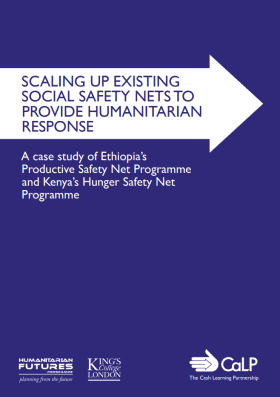
Scaling Up Existing Social Safety Nets to Provide Humanitarian Response: A case study of Ethiopia’s Productive Safety Net Programme and Kenya’s Hunger Safety Net Programme
Policy paper
A case study of Ethiopia’s Productive Safety Net Programme and Kenya’s Hunger Safety Net Programme. This thematic report has been undertaken as part of a 2013 research study entitled, Is Cash Transfer Programming ‘Fit for the Future’? The research was commissioned by the the CALP Network and...
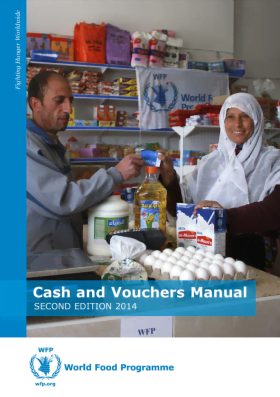
Cash and Vouchers Manual – Second edition
Guidelines and Tools
This second edition of the Cash and Vouchers Manual captures the latest corporately endorsed business processes and procedures, providing the most up-to-date tools (i.e. analytical, assessment, monitoring) that have been developed through close intra-departmental collaboration between Headquarters...
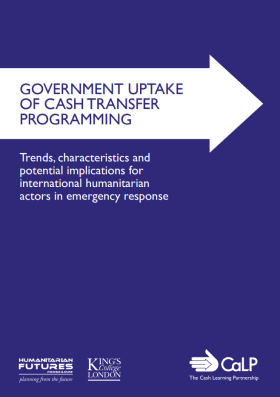
Government Uptake of Cash Transfer Programming: Trends, characteristics and potential implications for international humanitarian actors in emergency response
Policy paper
Trends, characteristics and potential implications for international humanitarian actors in emergency response. This thematic report has been undertaken as part of a 2013 research study entitled, Is Cash Transfer Programming ‘Fit for the Future’? The research was commissioned by the the CALP...
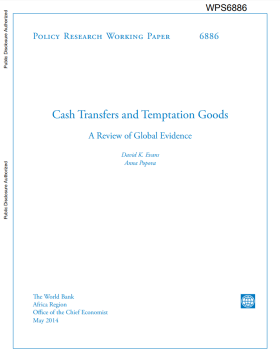
Cash Transfers and Temptation Goods: A review of global evidence
Report
Cash transfers have been demonstrated to improve education and health outcomes and alleviate poverty in various contexts. However, policy makers and others often express concern that poor households will use transfers to buy alcohol, tobacco, or other “temptation goods”. This paper reviews 19...
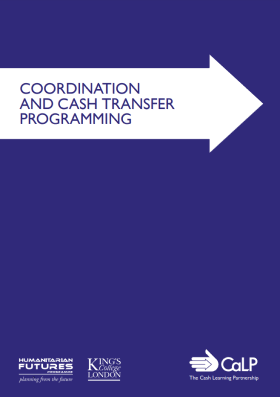
Coordination and Cash Transfer Programming
Policy paper
This thematic report has been undertaken as part of a 2013 research study entitled, Is Cash Transfer Programming ‘Fit for the Future’? The research was commissioned by the the CALP Network and undertaken by the Humanitarian Futures Programme (HFP), King’s College London. The overall...

Financing of Cash Transfer Programming
Policy paper
This thematic report has been undertaken as part of a 2013 research study entitled, Is Cash Transfer Programming ‘Fit for the Future’? The research was commissioned by the the CALP Network and undertaken by the Humanitarian Futures Programme (HFP), King’s College London. The overall...
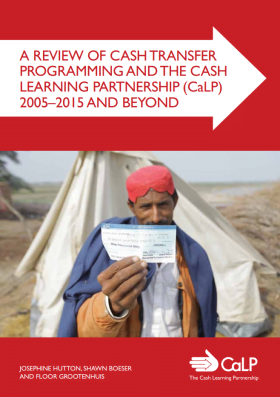
A Review of Cash Transfer Programming and the the CALP Network 2005–2015 and Beyond
Report
The core purpose of this review, commissioned by the CALP Network, is to evaluate the CALP Network’s progress since inception and examine the status and continued needs of cash programming in emergencies. Cash transfer programming (CTP) represents a significant shift in the way humanitarian aid can...
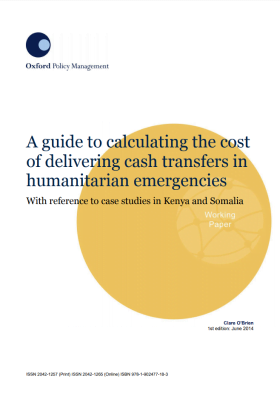
A Guide to Calculating the Cost of Delivering Cash Transfers in Humanitarian Emergencies – With reference to case studies in Kenya and Somalia
Report
The emergence of cash transfers as a viable alternative to in-kind aid – such as food or shelter materials – for households affected by humanitarian disasters has been documented for some years now. Under certain conditions, when local markets are able to accommodate increased demand and prices will...
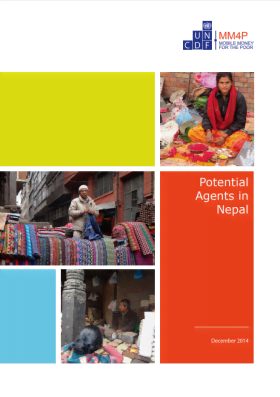
Potential Agents in Nepal
Report
Nepal is characterised by unique geographical diversity, with regions consisting of mountains (parbat), hills (pahar) and lowands (terai). Numerous financial institutions in a variety of forms—such as banks, savings and credit co-operatives (SACCOs) and microfinance institutions—are engaged...
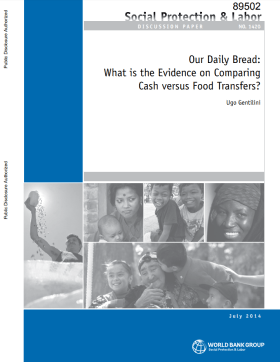
Our Daily Bread: What is the evidence on comparing cash versus food transfers?
Report
This paper reviews key issues in the ‘cash versus food’ debate, including as they relate to political economy, theory, evidence, and practice. In doing so, it benefited from a new generation of 12 impact evaluations deliberately comparing alternative transfer modalities. Findings show that...
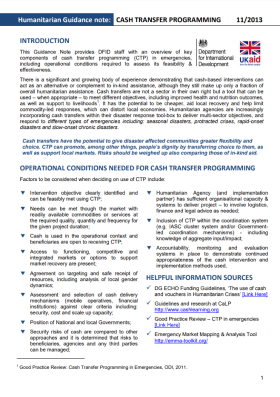
Humanitarian Guidance Note: Cash Transfer Programming
Guidelines and Tools
This Guidance Note from DfID provides an overview of key components of cash transfer programming (CTP) in emergencies, including operational conditions required to assess its feasibility & effectiveness. A brief guide to assist programme staff in writing funding proposals for cash-based interventions...
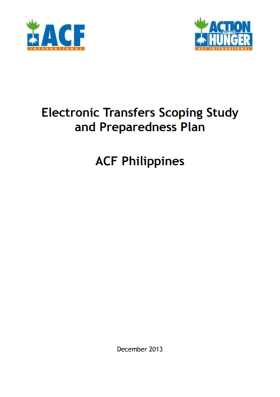
Electronic Transfers Scoping Study and Preparedness Plan
Policy paper
This piece of work was arranged by Action Against Hunger (ACF), with the intention of understanding the electronic payment services available in a minimum of two country missions and to support ACF in preparing for future humanitarian response in country and globally, with a specific focus on...
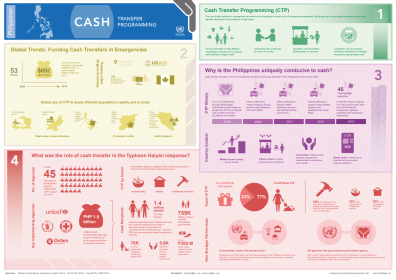
Cash Transfer Programming Infographic – OCHA
Presentation
OCHA (Office for the Coordination of Humanitarian Affairs) in the Philippines has produced a helpful infographic explaining the role of cash transfer programming in the Philippines Typhoon Haiyan response. The infographic explores several aspects of cash transfer programming, and examines the several...

Comparative Review of Market Assessments Methods, Tools, Approaches and Findings
Guidelines and Tools
Against a backdrop of climate change, global economic crises and commodity market volatility, food security experts are increasingly interested in deepening their understanding of how markets work. In 2011, the the CALP Network commissioned this study, which aimed to assess how we are currently analysing...
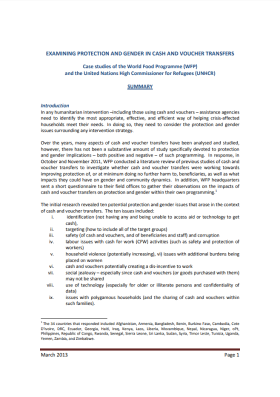
Examining Protection and Gender in Cash and Voucher Transfers – Summary
Report
In any humanitarian intervention – including those using cash and vouchers – assistance agencies need to identify the most appropriate, effective, and efficient way of helping crisis-affected households meet their needs. In doing so, they need to consider the protection and gender issues surrounding...
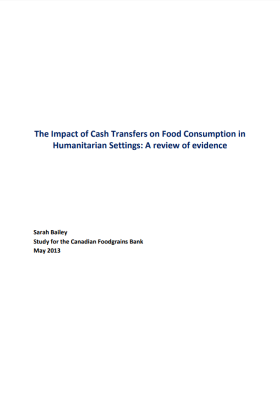
The Impact of Cash Transfers on Food Consumption in Humanitarian Settings: A review of evidence
Report
In order to make informed decisions on when to use cash, vouchers and food aid, it is important to understand evidence on their appropriateness and effectiveness in achieving certain objectives. A main objective of the Canadian Foodgrains Bank is to improve food consumption in emergencies, and this paper...
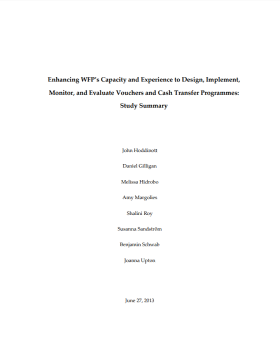
Enhancing WFP’s Capacity and Experience to Design, Implement, Monitor, and Evaluate Vouchers and Cash Transfer Programmes: Study summary
Report
With support from the Government of Spain, and in partnership with the World Food Programme (WFP), researchers from the International Food Policy Research Institute (IFPRI) evaluated four pilot projects to assess the comparative performance of cash transfers, food payments, and vouchers on household food...



